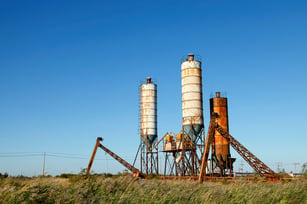 Loading cement trucks presents several safety hazards. Accidents often result in serious injuries or even fatalities, which is why it’s so important to make workplace safety a top priority.
Loading cement trucks presents several safety hazards. Accidents often result in serious injuries or even fatalities, which is why it’s so important to make workplace safety a top priority.
In the daily rush, it may be difficult for drivers and facility managers to imagine that an accident could happen on their watch. To safeguard your employees, it’s critical to proactively implement fall prevention practices designed to keep your workers out of harm’s way.
Here are four ways to boost worker safety at your cement loading facility:
1. Implement Proper Truck Spotting Procedures
In a cement loading facility, it’s critical that the truck is spotted correctly every single time. Otherwise, serious (and even fatal) accidents may occur.
Even with the right safety equipment, your employees are still at risk of an accident if a truck isn’t properly spotted.
If a cement truck is mis-spotted, the safety cage won’t align with the top hatches. Track mounting allows the gangway to be moved along the platform to help align the cage with the hatch.
When drivers attempt to open or close the truck’s hatch, they may be tempted to lift away the safety cage to do so. This exposes your employee to a fatal fall.
Proper truck spotting is one of the hardest practices to instill into your drivers and operators. However, for your facility to be considered MSHA compliant, your drivers must demonstrate correct truck spotting procedures.
Failing to implement safe truck spotting practices may have serious consequences, such as injuries or deaths, citations or fines, and MSHA shutting your facility down if it does not meet safety standards.
2. Install The Right Safety Equipment
Although safety equipment isn’t a substitute for proper truck spotting, it can help your operators in cases of slight variance.
Since cement truck hatches open on a perpendicular axis with the truck, it’s also important that you have an offset safety cage with flip-up panels to allow the hatch to pass through the cage. The flip-up panels on the offset cage means an operator doesn’t have to lift away the entire safety cage just to open or close a hatch – avoiding a safety hazard in the process.
When choosing safety equipment for your facility, always work with a trusted vendor that can help you develop a solution for your site’s specifications.
3. Provide Safety Training For Employees
The cement loading and unloading process is dangerous for employees when they don’t know how to properly use the safety equipment. If an employee is injured while using equipment they haven’t received training on, your company is at risk of a lawsuit.
Train your workers on how to safely use all equipment, avoid common workplace hazards and overcome any obstacles they may face. Simply having fall prevention equipment in place is not effective if your employees don’t know how to safely use it.
4. Maintain Safety Equipment
Safety equipment in the cement industry tends to experience a significant wear and tear. It’s critical that you walk around your facility on a regular basis to check your equipment for signs of wear. If you notice any issues, fix your equipment as soon as possible, as faulty fall prevention equipment may lead to falls and injuries.
Implementing fall prevention strategies designed to improve workplace safety isn’t an option – it’s a necessity. Accidents hurt employee morale, throughput efficiency and your bottom line. Combining proper truck spotting practices with safety equipment and employee training makes your loading/unloading process safer for your employees.
Learn more about the importance of proper truck spotting by downloading this free industry guide from Carbis Solutions.



